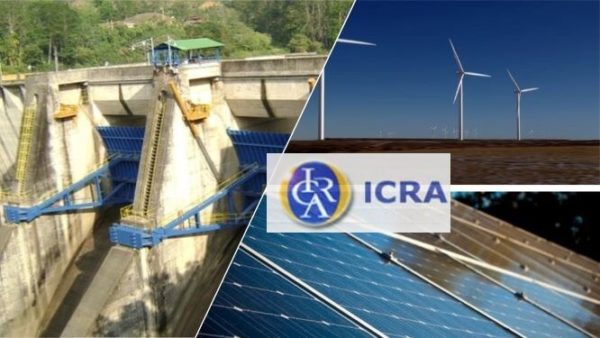

Putting a spotlight on the problems that the renewable energy sector in India is currently facing, the Investment Information and Credit Rating Agency of India Limited or ICRA in its latest sector report says that India will add about 8 to 8.5 GW in the latest Fiscal Year 2018-19, ending in March 2019, followed by healthy growth next fiscal (2019-20) too. The numbers, while well below targets for the country to hit the 175 GW mark by 2022, are still considered good by experts, considering the challenges the country’s policy environment throws up from time to time.
“The project awards so far provide a reasonably healthy visibility for RE capacity addition in FY2019 and FY2020 with the expected addition of about 8-8.5 Gw in FY2019. This apart, RE projects are likely to remain cost competitive against conventional power sources,” said Sabyasachi Majumdar, Group Head-Corporate ratings, ICRA Ltd.
Share of Renewable Energy
The share of renewable energy in overall installed power generation capacity has increased from 9 per cent in March 2009 to around 20 per cent (which translates to capacity of around 71 GW) as on June 2018, rating agency ICRA added in the report. More interestingly, 2018-19 will be the second year where net renewable additions will comfortably beat fossil fuel based capacity additions.
ICRA expects the share of renewables in the total generation mix to increase by 5 per cent in next four years – from 7.7 per cent in FY18 to 12-13 per cent by FY22.
According to research and rating agency ICRA, the bidding activity in the renewable energy sector has remained sizeable with central agencies like the Solar Energy Corporation of India (SECI) and NTPC Ltd (NTPC) as well as state distribution utilities issuing bids for wind and solar power capacities of about 10 GW and 15 GW respectively during 2017 and 2018. While this auger well for the sector, several key concerns remain.
“Renewable projects are likely to remain cost competitive against conventional power sources. However, the imposition of safeguard duty on imported PV modules and the recent rupee depreciation against dollar is estimated to increase the capital cost of solar power projects by 20-25 per cent, though impact of this is partly moderated by the decline in the PV module prices by about 20 per cent since June -2018,” Sabyasachi Majumdar, Group Head – Corporate ratings, ICRA Ltd, said.
Rupee and Safeguard Duty pressing Margins
UN report in April had warned that solar activity was held back by an unexpected rise in PV module prices in local currency terms, due to a sudden reduction in the oversupply of imported Chinese units, exacerbated by the imposition of a Safeguard duty on modules.
There is also a slowing in the pace of solar auctions around India. A sustained fall in the value of the Rupee impacts most import-centric industries including solar. A bigger reason is the government’s single minded focus on driving down renewable prices, which, industry players claim, can lead to quality compromises as well as lower interest. A bigger facor of course could be to push for ways to make renewable power the source for significant parts of the subsidized power regime, especially in the agriculture sector, a situation that has bled many discoms dry and unable to buy power . Supply from cheaper renewable power could help the government take a huge load from the discoms and push them towards some semblance of fiscal health, as renewable power supply aligns well with the need for agricultural power in the daytime.
“Our analysis indicates that with the imposition of the safeguard duty alone, tariffs could increase by Rs 0.30 per kWh to Rs 0.35 per kWh, considering a 25 per cent safeguard duty, while a Re 1 depreciation in the exchange rate typically translates into a 2 paise per kWh increase in tariffs of projects in order to maintain their profitability,” said Arindam Som, a senior analyst at India Ratings and Research, a Fitch Group-owned research agency.
Earlier last week, Wood Mackenzie in its forecast said that India will achieve 75% of its target of 175 GW by 2020, as it faces myriad challenges.
Another leading ratings and research agency CRISIL predicts a big shortfall in India’s original 175 GW renewables target by 2022. The agency says that India’s renewable energy generation capacity is expected to reach 140 GW by 2022-23.
These reports come after the Prime Minister Narendra Modi reiterated at the REInvest Expo and Exhibition that the government is committed to ramp up the country’s green energy capacity base to 175 GW by 2022 from the current 72 GW.
1. The mandate for blending Compressed Biogas (CBG) with natural gas has come into effect…
Andhra Pradesh is striving towards greening its energy sector with quite some speed. In a…
With an objective to bolster India’s green energy goals, a Tripartite Agreement has been signed…
The Union MNRE Minister Pralhad Joshi launched the Green Hydrogen Certification Scheme of India (GHCI)…
India’s energy conglomerate Bharat Petroleum Corporation Limited (BPCL) has commissioned a 5MW green hydrogen plant…
In a historical development, the European Space Agency (ESA) has successfully launched its pioneering ‘Biomass’…